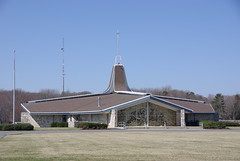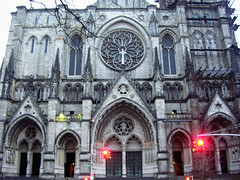Thursday, December 31, 2009
Tuesday, October 27, 2009
Thursday, October 22, 2009
The White Dove of the Desert
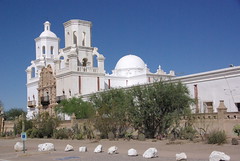
San Xavier del Bac
Originally uploaded by millinerd
The White Dove being San Xavier del Bac. There is just too much to tell about my trip Southwest. I found the trip confirmed this blog's motto in two ways: It is all here anyway, and planes, especially domestic ones, are indeed tedious.
Friday, October 9, 2009
Tuesday, August 25, 2009
When They Begin Demolition Of Your Church
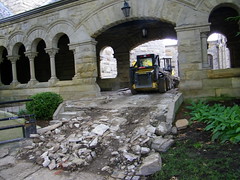 OK, that’s a bit over-dramatic. More like: When They Begin Demolition At Your Church. We take a few weeks each summer to visit other churches: to broaden our worship experiences, to hear certain ministers preach, to refresh memories. This is satisfying and, I think, valuable. There is always a twinge, knowing that we are missing the worship we cherish so much. And, our three associate pastors are in the pulpit much of the time in July and part of August, and they are all excellent preachers.
OK, that’s a bit over-dramatic. More like: When They Begin Demolition At Your Church. We take a few weeks each summer to visit other churches: to broaden our worship experiences, to hear certain ministers preach, to refresh memories. This is satisfying and, I think, valuable. There is always a twinge, knowing that we are missing the worship we cherish so much. And, our three associate pastors are in the pulpit much of the time in July and part of August, and they are all excellent preachers.And so, it was with anticipation that I walked up Westminster Avenue toward Shadyside Church and that sweet encounter with God’s Grace. I regretted that my wife had to attend a rare Sunday meeting at work. I saw the orange fencing and blue dumpster from a distance. I was about to steel myself when I recognized a young couple we know bringing their daughter for baptism. The warmth of that greeting was still with me when I turned and saw the rubble and machines in what had been the peaceful cloister/courtyard between the church and chapel.
I had been expecting, even looking forward to, the beginning of the renovation that emerged from the vision of Building Community for our church. I told myself that it was excitement, not anxiety, that attracted the butterflies to my stomach. I tried to stave off both by documenting the scene in photographs. The blur in half shots belied my sentiments. Even so, I was able to picture the bright, open atrium that will be the church’s “living room,” where we welcome strangers and relax with our church family.
Inside the sanctuary, the sight of old friends and a good crop of visitors settled me. Three chimes and the processional hymn brought my focus to worship. I did not try to put demolition/construction out of my mind. Our sermon was titled “Praying Your Renovation,” with the text describing Nehemiah, mourning the need to rebuild Jerusalem’s walls, which led him to pray. Our Pastor, Craig Barnes, as he always does, was speaking the subtext of scripture into our lives. Our congregation and its leaders had discerned God’s will to include changing our walls to become a place of greater hospitality, for visitors, for members, for those we have the privilege to serve.
Craig spoke about the presenting issue: the anxiety and inconvenience of a construction project. Then he invited us to consider those parts of our lives that need renovation: a relationship, a career, a health concern. Prayer drives our plans to become a part of God’s vision for our lives and for those he wants our lives to reach.
I came away reminded that bringing my anxieties before God rarely causes the anxiety-producer go away. There are times when the things I worry about actually happen – sometimes they are worse than I feared. Faith is trusting that God is ready to redeem every situation with his perfect vision, in his perfect time. And, lest faith become a palliative, Craig’s charge to us was bracing: God’s plans always include change.
Tuesday, July 28, 2009
Boston Apotheosis
As I flew back to North America, therefore, I couldn't help but think I was returning to the land of the naked church. During an all too brief trip in Boston, I braced myself for Puritanism. Harvard's main chapel was a fitting expression. My insistence that Protestant iconoclasm is a dangerous thing, in addition to being completely missed by Christianity Today (who - how could they? - puffed the same Vineyard church I criticized, lending a whole new level of meaning to Our Lady of Pity), was confirmed at Harvard. There, in the beautiful but bare central campus chapel, our tour guide had us sit down for what could only be described as a sermon. He explained to us, rather passionately, that chapel doesn't really mean anything to Harvard students because Harvard preaches... sorry, make that "values" pluralism.
At any rate, few things could have prepared me for what I can only call my Boston apotheosis. Despite a good many trips to that famed city, I had the embarrassment of having never visited Trinity Church. But I somehow missed it on my way through Back Bay, and ending up on Boston Common (onetime home of an Anglican hermit), where I decided to take the Freedom Trail tour again. An immersion into Puritan Boston proved another confirmation of my "land of the naked church" theory. Towards the end of the day, I bought a map and made my way to Trinity. I approached at the high noon of church photography (just before sunset), and the impression was overwhelming. Copley Square shows the land of the naked church gloriously clothed (well, sort of).
Trinity Church was like an invading Romanesque spaceship that landed in Puritan Boston to wreak medieval havoc. As I enjoyed the interior tour, I couldn't help but think that just as Justinian, after building Hagia Sophia, could exclaim, "O Solomon, I have surpassed thee," so Richardson and LaFarge might have been justified in exclaiming, tongue in cheek of course, "O Justinian, I have surpassed thee." A window within suggests the same. Having secured this beachhead of Boston decoration at Trinity, the assault continued across the street at the marvelously Ruskinian Old South Church. And let's not even get started on the Boston Public Library, the flagrantly luxurious celebration of McKim, Mean and White, capped with the career triumph of one who is certainly a contender for finest American painter status, John Singer Sargent. How telling to the state of American art history that the theological import of this work has been only lately brought to light.
The glory days of American architecture before modernism can perhaps be best understood on that square in Boston: The fabulously financed revenge of the medieval on the Puritanism that tried to escape it. Still, my point that whitewashing walls leads to whitewashed doctrine is not always applicable. One cannot, for example, suggest that Trinity is a bastion of classical Christianity, whereas the perfectly plain Park Street Church is much closer to earning that distinction. When it comes to theological destiny, there are much more determinative factors that art and architecture; but that said, art and architecture sure can help - the ideal should be form and content, not or.
Monday, June 8, 2009
Friday, June 5, 2009
Tuesday, May 26, 2009
After Immanence

I've found Mark Torgerson's irenic explication of modernist church design, An Architecture of Immanence, a helpful resource, especially the wonderful appendixes. Here's an online review. What the reviewer does not mention is that at the end of the book, Torgerson - who is deeply sympathetic to modernism - admits its failure, and points to the need for some kind of return to traditional architecture. The assumptions of liberal Protestant theology that were yoked to modernism, in Torgerson's words, "have been proven false." At the risk of self-linking, I like to think this puts Torgerson in agreement with Bess and Glazer.
You can read the entire conclusion at Google books, which is well worth doing.
Friday, May 8, 2009
The Pulpit

Wednesday, April 1, 2009
St James-the-Loss ?
The founders of the Cambridge-Camden Society believed the antidote to the evils of the 19th century was a return to medieval piety. Their early thrust was restoration of the medieval architectural setting for worship in the Anglican Church. Their generosity of advice was paired with their prickly attitude toward anyone who did not accept it wholeheartedly. Their zeal extended to “the colonies” which resulted in one of the most charming and influential churches in America, St. James-the-Less in Philadelphia. (The Society lives on with only a short break in continuity as The Ecclesiolgoical Society.)
In response to a request to the Society for design assistance with their Episcopal church, the Pennsylvania congregation received measured drawings of a 13th century parish church, St. Michael’s, Longstanton, Cambridgeshire. The congregation faithfully reproduced the model high above the Schuylkill River, changing only the length of the structure and selection of stone in the 1846 construction.
In fine ecclesiological fashion, the nave and long chancel are clearly expressed in the exterior massing of the building. The later addition of the sacristy only enhanced the picturesque composition – a guiding principal of the increasingly archeological Gothic Revival. The long steep rooflines, as seen on the south porch entrance enhance the sense of shelter and worshipful repose.
On a recent visit, the cold, drizzly day seemed appropriate to the disuse into which St. James-the-Less has fallen in the past several years. This is not to be blamed on neglect. The too-familiar story is of a congregation, rejecting the theological trajectory of the Episcopal Church, disaffiliated itself from the denomination. The odd result of legal wrangling held that the congregation owned the church building, but held it in trust for the diocese, who evicted them. We should not force too much irony on the fact that the congregation now worships in a nearby cemetery chapel – as much of charm of St. James-the-Less is its setting among gravestones, old and not-so-old.
Given the situation, we had no expectation that we could even gain access for exterior photography. Happily, we were greeted by a young man associated with another diocesan church, who was waiting for visiting group. He offered to let us tag along with a small group of clerics from the Reformed Catholic Church.
That ushered us into the church where darkness and sight lines obstructed by columns and by a rich rood screen were a reminder that lay participation in the medieval mass, celebrated in the divided chancel, was decidedly passive. Electric lighting struggled against the shadows, while the discoloration of the arcade springing was attributed to match strikes for the original chandeliers. Discolored stone on the pulpit indicated a hand rest for the deliverers of countless sermons.
In addition to the pulpit, the expected liturgical centers were there, altar, lectern, font, side chapel. The stained glass was obviously there to set a mood and tell a story rather than provide illumination.
St James the Less has been assumed as a mission by St Mark’s, the historic John Notman church in Center City Philadelphia. They should have experience and skill in preserving and using a historic structure. Let’s hope that they can do that. Nothing leads to loss like disuse. Nothing preserves like an active, resident congregation. Loss or damage of St. James-the-Less would be tragic from an architectural standpoint. From a spiritual standpoint, good stewardship demands a Kingdom use of this treasure.
UPDATE: I had a pleasant email exchange with Father Ousley, rector of the congregation formerly at St James. He confirms that the attribution of marks on the column springing to match strikes is in a written church history. However they have determined that the discoloration is from greens hung at Christmas. The congregation presently worships at the chapel at West Laurel Hill Cemetery. He also relates, "West Laurel Hill was founded by the same gentlemen who founded Laurel Hill Cemetery, and gave St James the first part of the land on which it is built. A nice historical touch."
Monday, March 23, 2009
Europe and then some
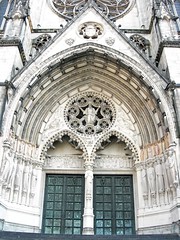
saint john the divine 1/5
Originally uploaded by musiquegirl
Just to prove this blogs motto, "it's all here anyway," here are Ghiberti's North American doors. Cram would have none such copying, by the way, hence he commissioned impressive new bronze doors (depicted above) for St. John the Divine. Some nice details of the south New Testament door here.
.
Incidentally, Maureen Mullarkey's article on the North American tour of the original Gates of Pardise is a tour de force.
Thursday, March 19, 2009
Saturday, March 14, 2009
Flannery's Church

Cathedral of St. John the Baptist, Savannah
Originally uploaded by millinerd
John H., a friend who was driving through Savannah, sent in this shot (with info) of the home church of Flannery O'Connor. There is some nice exegesis of the interior at the church website, but I thought the menacing trees in John's photo was very O'Connoresque.
Friday, March 6, 2009
Cathedrals Gone Wild
Call me prudish, but I thought St. Bernard's stained glass vision was a bit much. Not to mention Ruth seducing Naomi in the stonework. Then there's the matter of the pin-up tympanum on the National Cathedral in Washington D.C. It will come as no surprise that these are both Episcopal Cathedrals.
I'm well aware that salacious imagery on churches has a long history, and I'm all for a nuanced appreciation of Bernard's Song of Songs sermons, but about these depictions I just don't know. Yes, the Christian tradition teaches that the body is good - but it also teaches that we aren't. Hence, you can get away with things in the realm of literature that you can't get away with in art. Still, I would represent my level of suspicion in regard to these representations as a yellow light, not necessarily a red one - though I'm open to being convinced otherwise.
What I can say is that at least at the Saint John the Divine portal, most will be distracted by a more remarkable carving, the twin towers falling in an imagined apocalyptic scene, carved in... wait for it... 1997.
Monday, March 2, 2009
An Architecture Timeline
Complimentary Cram
Friday, February 20, 2009
Good Enough for Horses

Some of the goals of Shadyside Presbyterian Church’s Building Community Capital Project include a welcoming fellowship space adjacent to the sanctuary, a recognizable Westminster Place entrance and easy, accessible circulation within the structure. The complexity of the pastor’s directions to the Parish Hall for coffee hour can be risible. The journey includes going outside, negotiating steep stairs or traversing the mysterious undercroft.The enclosure of the cloister courtyard accomplishes the goals, and in the bargain re-establishes an old north-south circulation axis.
For its first forty-five years, Shadyside Church consisted of the sanctuary building and the chapel joined by a colonnaded walkway, separated by a narrow space. The human scale of the present entrance opening to the street obscures its original purpose.In 1890, some would have arrived at the church by horse and carriage. It has been a matter of mild curiosity that there was no obvious porte-cochere – so common in that era.
By the 1930s, auto travel made the passage unnecessary or impractical. Addition of the chancel apse and office space made it impossible. The elevated floor level in the colonnade and the raised ground level between church and chapel allowed the original use to fade from memory.A new porte-cochere will be extruded toward the street from the existing segmental arch opening – shelter at the new Westminster door. The renewed circulation axis will extend through the atrium to ministry/business offices as well to a new stair tower to the Parish Hall and Christian Ed/Nursery School facilities. (The existing elevator offers alternate access.) At the head of the stair, a window will look down into the renovated Parish Hall. The atrium will not only be a pass-through, but a convenient gathering space after worship, with ample access to the welcoming Parlor.
The rediscovery of the original circulation axis pathway did not suggest its re-establishment. However the size, shape and location of the courtyard that replaced it did. More detail of the project plans are here. A now & then comparison.
Wednesday, February 18, 2009

Set design for "Shrek the Musical"
Sometimes it's not the sun bursting through the rose window, but another sphere entirely: The wrecking ball. A while back at the First Things blog, there was a tenderly written essay by Stephen Vincent about demolished neighborhoods in New York City.
I lived through Vatican II, receiving First Communion at the council’s close in 1965 and Confirmation in 1967, as the new Mass and other innovations got their sputtering starts. By 1969, the school and church along First Avenue were closed and another wrecking ball came crashing through the stained glass and fine masonry. The strongest support and sanctuary in a changing city had gone away, in the most violent fashion imaginable. The world, it seemed, had won.It reminds me of that awful scene at the end of Schrek (I) where the dragon smashes the stained glass, after which I suppose all the kids in the audience are supposed to cheer.
For another heartbreaking tale of urban destruction, consider this characteristically insightful John J. Miller interview (who has a gift for asking good questions). The Little Pink House is a cautionary tale. I wonder how many churches have been destroyed under the aegis of eminent domain.
Tuesday, February 17, 2009
For all your Akron-Style Needs

I found this ad in the 1910 Baptist Yearbook, for help in converting your space to an Akron-like style. See how easy they are?
Wednesday, February 11, 2009
Wednesday, February 4, 2009
Saturday, January 24, 2009
First Baptist Church of Hightstown, NJ
Growing too large, the church built in 1856-1857 the present sanctuary, which seated about 600. The place where the organ is (a 1914 Austin) was added on, I believe, in 1881 when a Roosevelt organ was given by Wilson G. Hunt. The addition is the perfect time for the inclusion of the proscenium arch, which was common in the period and focuses attention to the pulpit area. Although today the walls are a plain yellow, this photo from the 1910s shows the extensive decorative work that was there, as well as the large chandelier that is no longer present.
The original steeple was very tall, as seen here and here. It is a classic Wren-Gibbs style church. The steeple was struck by lightning during a Peddie school program, and so in 1920 (I believe it was) a second steeple was built. This one has a slightly more Federalist look than before, and almost overpowers the building. That steeple was condemned in the 1950s because of weakness caused by the swinging of the bell, and the current one was built.
The church has recently completed a renovation of the sanctuary, so I will leave you with some pictures of the new space. The pulpit was extended into the room, and it was brightened up a bit with new paint and lights.
Tuesday, January 20, 2009
Saturday, January 17, 2009
A 19th Century Baptist on Architecture
"...when we come to the exterior of churches I hold to what you may call the ecclesiastical idea. I don't like to see a church which is like every thing else, like all the buildings on the street, like all the public buildings. I like to have something uncommon, something which we have inherited, something which has come down with our Christianity; not a radical innovation, not some brand new thing which has been conceived by some rabid architect, but the old-style structure with its spire pointing heavenward, with the familiar form which marks it as the house of God, with the sign that it is set apart to the uses of religion, that is what I want to see."
Interesting, especially since they were meeting in the former theater, Boston's Tremont Temple.



